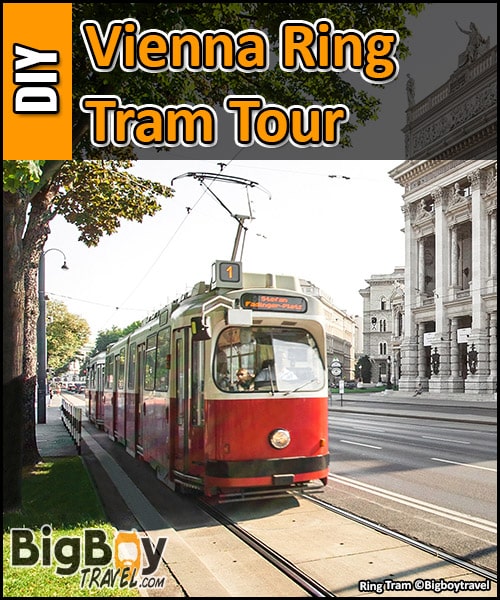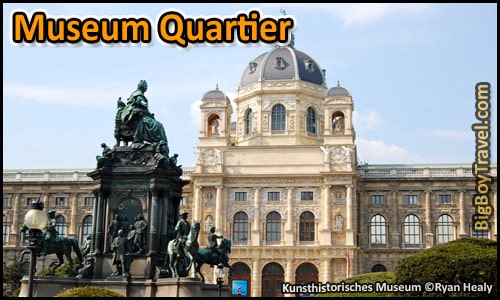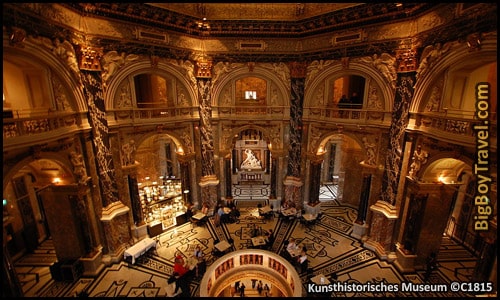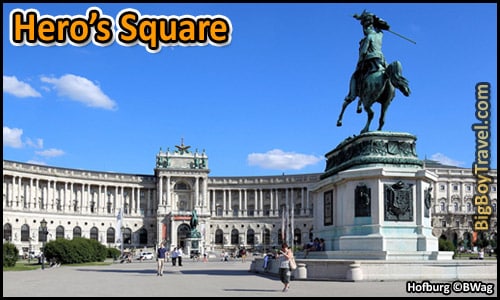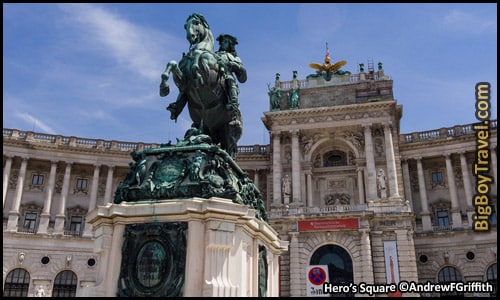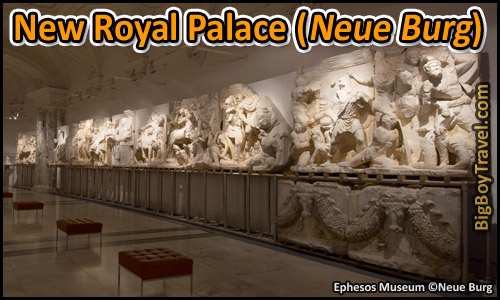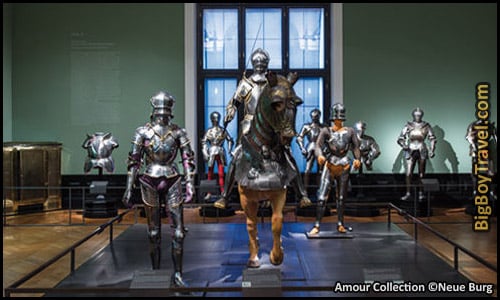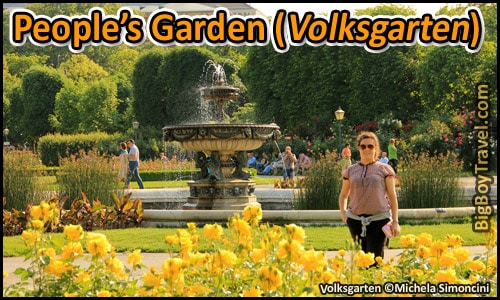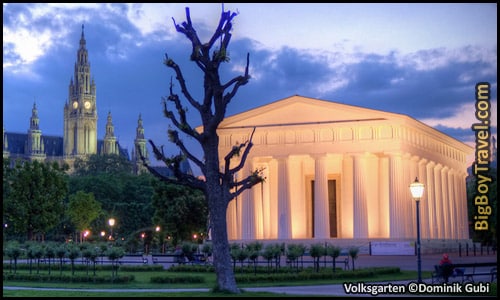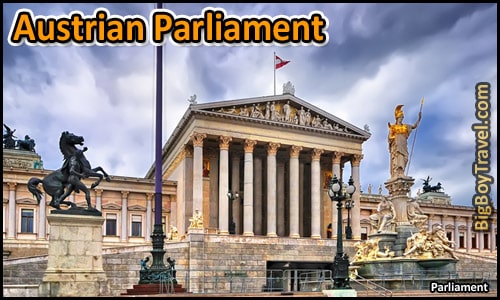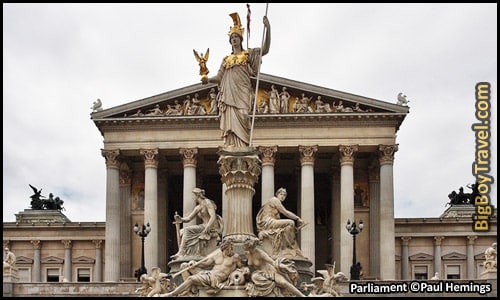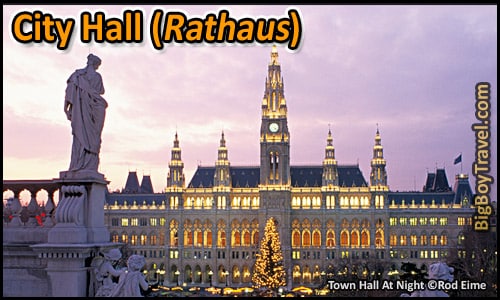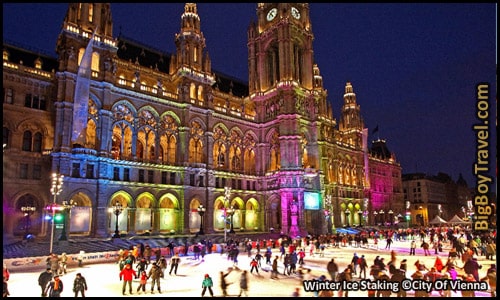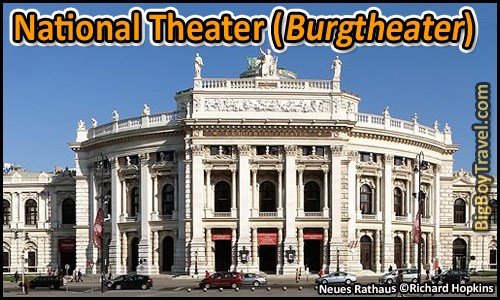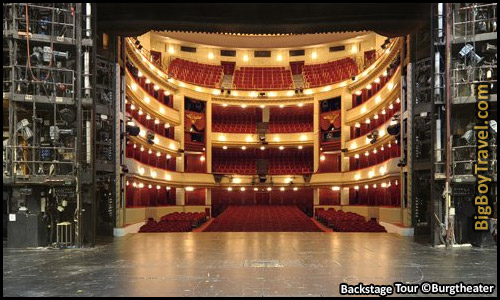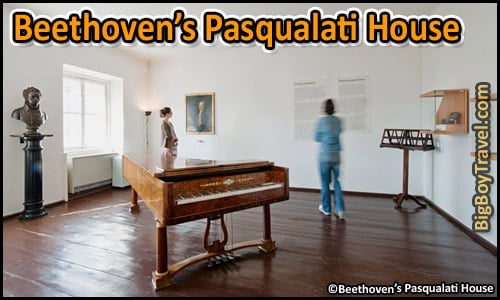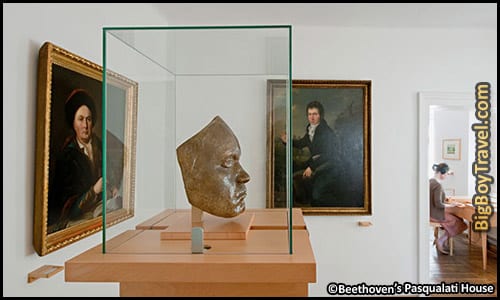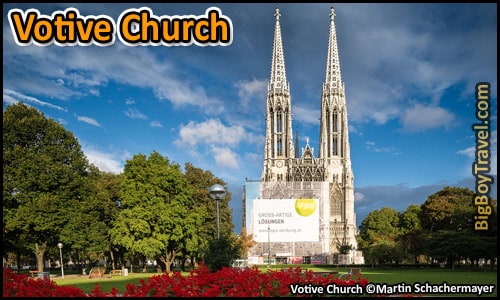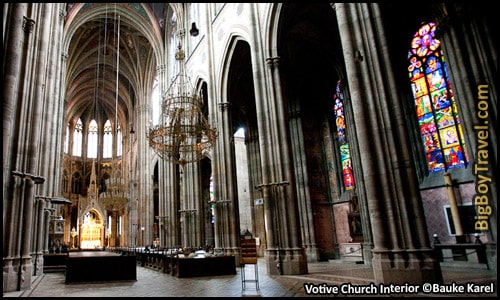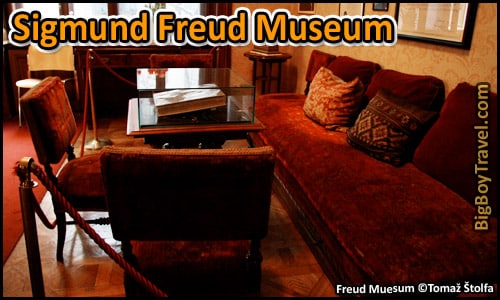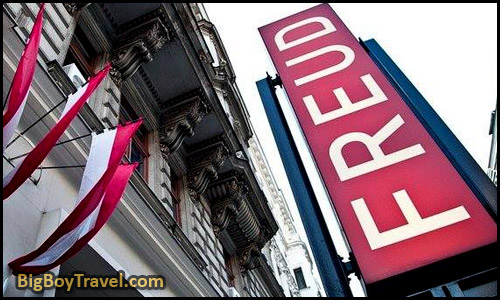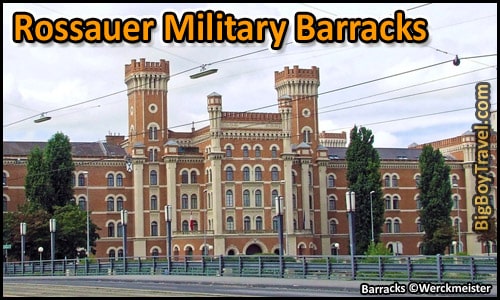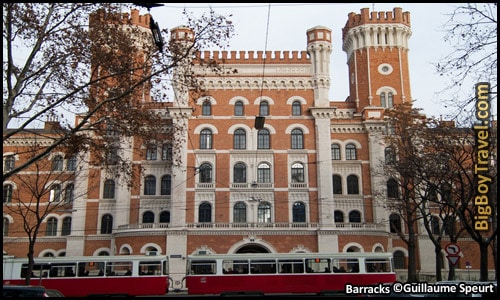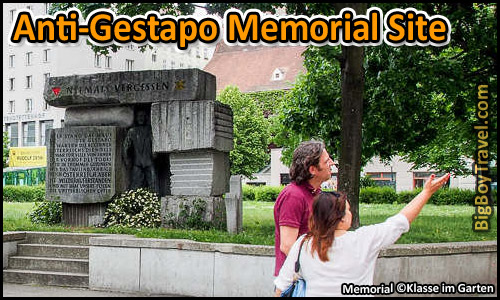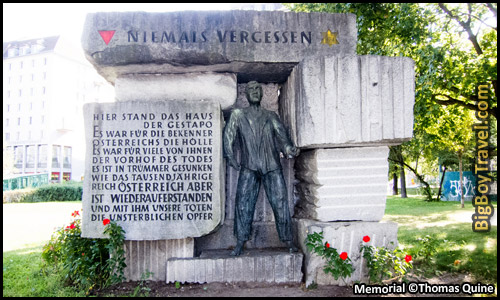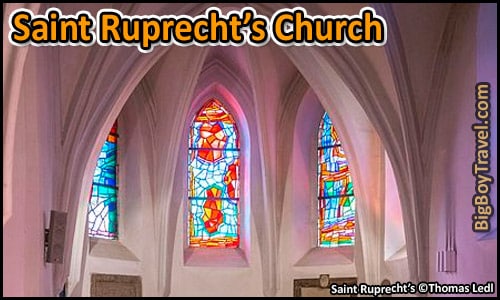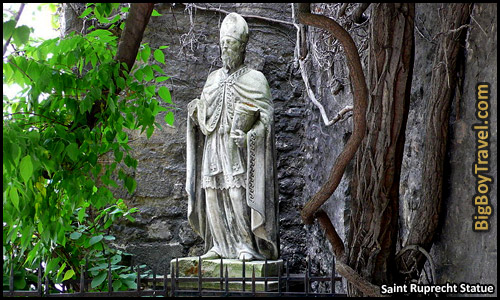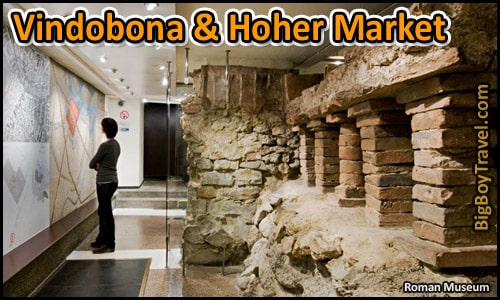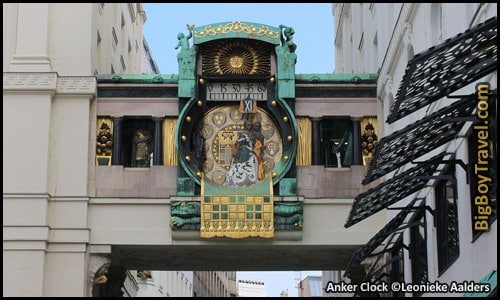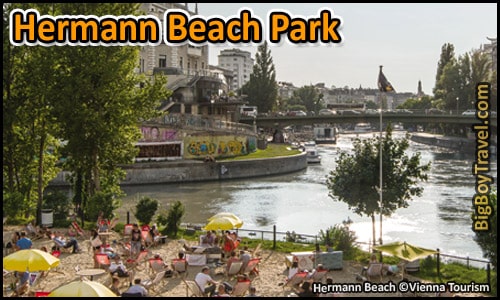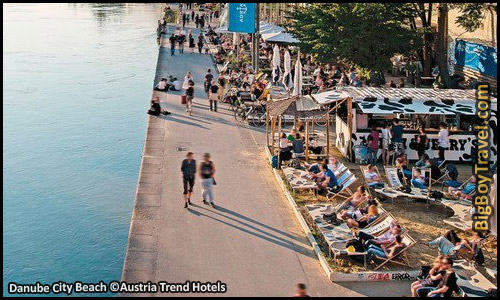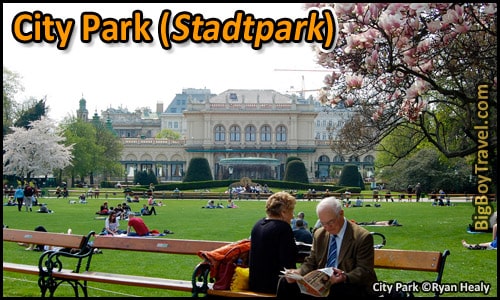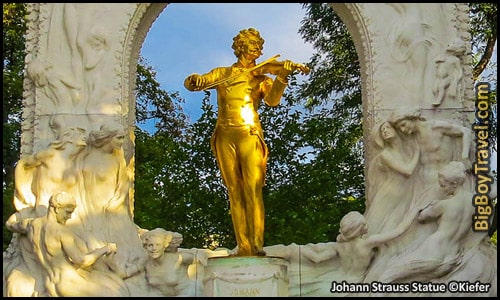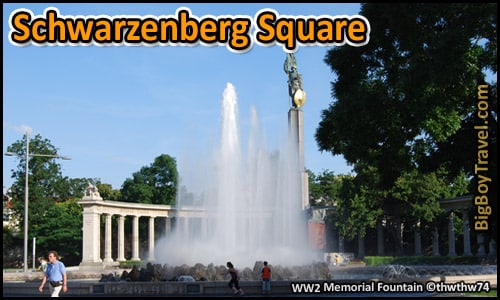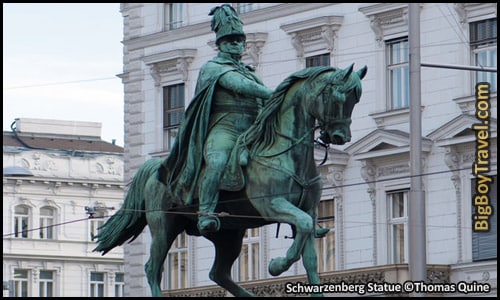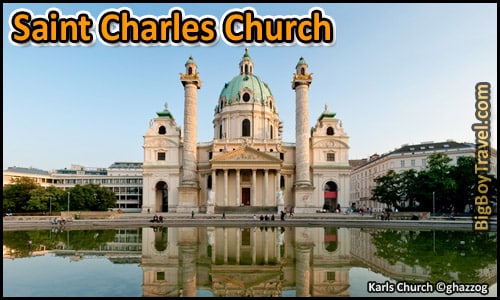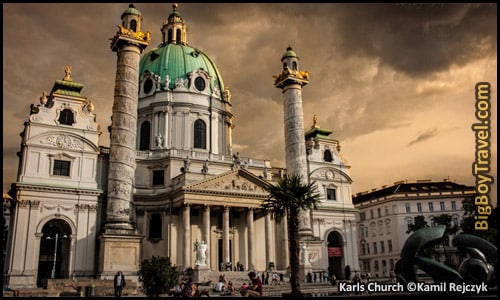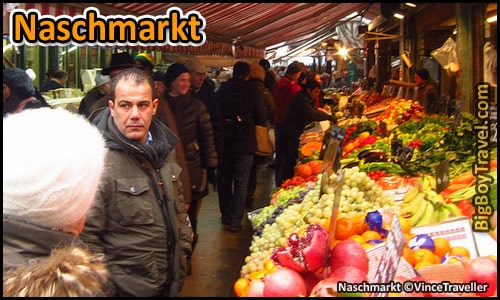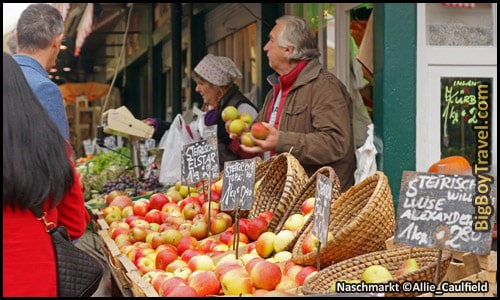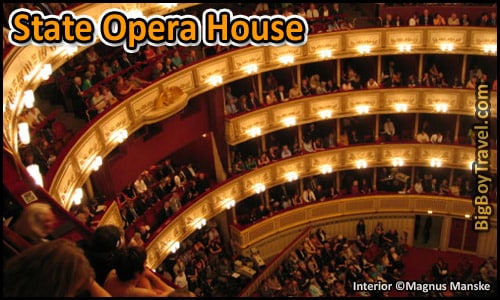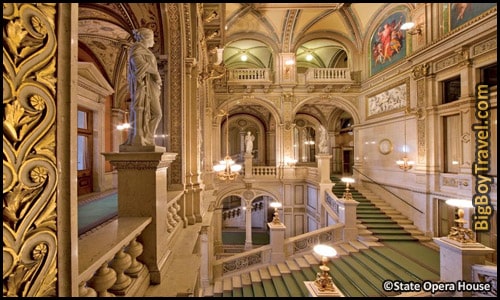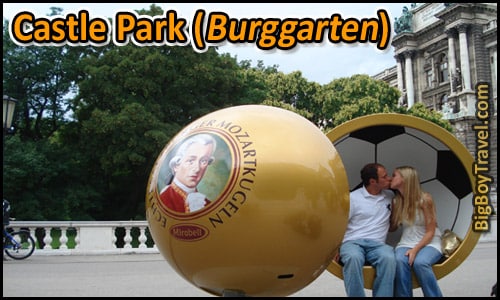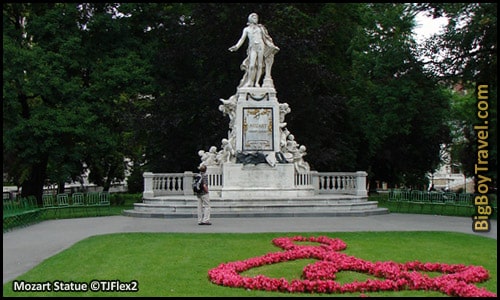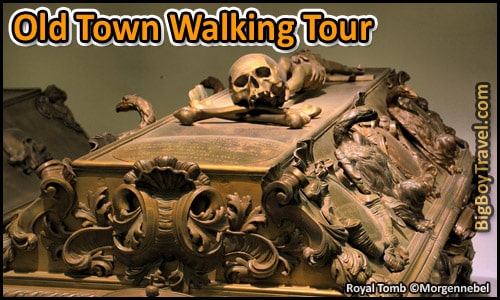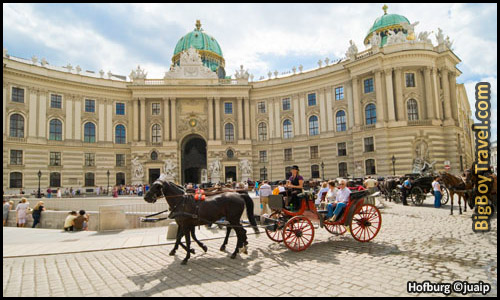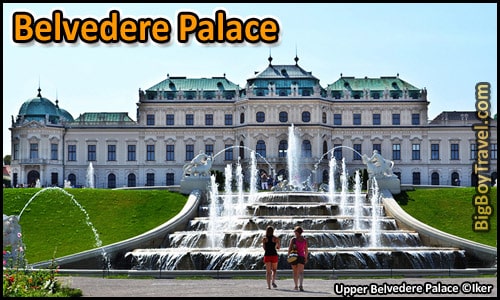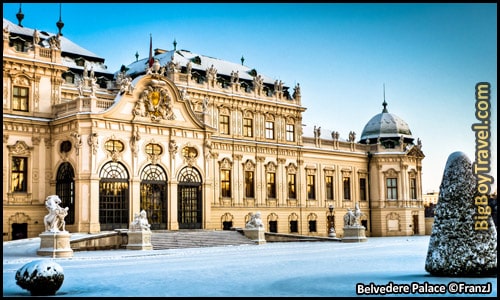Ringstrasse Tram & Walking Tour:
Location: Vienna’s Ringtrasse (Ring Road).
Cost: Free, 4-14€ for tram pass (optional prices below).
Style: Do-It-Yourself Hop-On Hop-Off Tour (Self Guided).
Start: Museum Quartier (Museumsquartier Subway Stop).
Stop: Burggarten (Burgring Tram Stop).
Map Key: Red Tram #1 is in BLUE, Red Tram #2 is in RED, Trams #71 & #D are in PURPLE, and the Yellow Tourist Tram is in YELLOW. Subway lines are also marked.
Distance: Tram loop is 3.6 miles (additional walking is light).
Time: 25 Minutes for loop (4-5 Hours with stops).
Fun Scale: 9 out of 10.
Ringstrasse Tram Tour Overview:
The 3.2-mile-long Ringstrasse (Ring Road) looping around Old Town Vienna traces the path of the impressive Medieval wall that once protected the city. The Medieval wall was completed in 1257 as an expansion outward to accommodate the flourishing trade town. This new wall was very heavily fortified with watchtowers & bastions, was surrounded by a moat, and ringed with a wide building-free meadow (glacis) separating the city from the suburbs. This protection helped Vienna fight off the Turkish Sieges of 1529 & 1638 which may have saved the rest of Europe from being overtaken.
Vienna kept prospering over the centuries, and by 1860 the then 500,000-person town needed to grow outward again. With the urging of controversial Mayor Karl Lueger, Emperor Franz Joseph had the Medieval wall tore down and the dry moat filled into to create a grand boulevard to help modernize the expanding city. During the massive project, the Ringstrasse (pronounced Ring-Strassa) quickly became lined with some of Europe’s most impressive buildings and gave the needed space for Vienna’s population to explode. By 1900, Vienna had grown to 2.5 million people and the 5th largest city in the World at the time. You can imagine how the grand Ringstrasse became the place to see and be seen.
Today the spacious Ringstrasse is as delightful as ever with world-class museums, inviting beer gardens, grand cathedrals, and impressive architecture on every block. To help you get the most out of your visit, we have put together a helpful do-it-yourself Vienna Ring Tram Tour so you can visit all of the best sights. Consider it a very easy hop-on, hop-off walking tour around the Ringstrasse that you get to do at your own pace. We have also included tips to help you utilize the public transportation options (tram & subway) listed below to help save your feet as some of the sights are spread out. Hope you enjoy our Ringstrasse tram tour in Vienna!
Suggested Tram Line Options:
1. Red #1, #2, #71, & #D Trams:
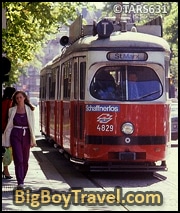
While the Tram #1 and #2 lines overlap for part of the Ringstrasse you will have to switch lines halfway through to complete the full loop. Each line goes a couple of miles out of the way where they split from the loop so you have to pay attention when it’s time to switch lines. In the East, Tram #1 splits off with access to the Hundertwasserhaus and Prater Amusement Park while Tram #2 splits off to the North to Augarten Park with its famous Flak Towers.
Another helpful set of Red Trams are #71 and #D (purple on our map) which run up the Western and Southern side of Vienna’s Ring Road along the same tracks as #1 & #2. This stretch is where most of the sights are making these two trams a good addition to your tram tour mix. As they exit the Ring Road in the East, Tram #71 runs along the Northside of Belvedere Palace all the way to both Mozart’s and Beethoven’s Graves (see our map). Tram #D splits to run along the Southside of Belvedere Palace for easy access to see the grounds and goes all the way to Vienna’s Main Train Station.
Red Tram Hours: 4am-Midnight, every 5-10 minutes. Tickets: Single ride tickets are 2.20€ and you’ll have to use one every time you get on. Unlimited City-wide Tram/Bus/Metro Pass is 7.60€ for 24 Hours, 13.30€ for 48 Hours, & 16.50€ for 72 hours.
2. Yellow Tourist Tram:
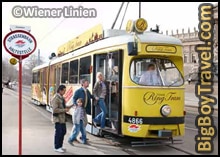
Please note that the Yellow Tourist Tram no longer lets you get out at any of the attractions during your loop. Although it doesn’t have a hop on hop off tram tour option, this line is enjoyable if you want to take in all the sights quickly. This 31 seat tram is complete with LCD screens going over the highlights and has headphones for narration in 8 languages.
Yellow Tram Hours: Daily 10am-6pm; last Yellow Tram leaves the Schwedenplatz Tram Stop at 5:30pm. Yellow Tram Tickets: A special ticket is needed to ride this tram for a one-time 25-minute continuous loop ride which costs 10€ (5€ for children). More Info: Yellow Tram Website.
3. Underground Subway:
About The Subway: While the road level tram lines are the best way to experience the Ringstrasse, you can also hit up most of the sights by using Vienna’s extensive underground Subway lines (marked on our map as thin lines). Printable Subway Map: Click Here.
Vienna Ringstrasse Tram Tour:
1. Museum Quartier:
About The Museum Quartier: We love to start our Vienna Ring Tram Tour on foot exploring the Museum Quartier which has the best collection of museums in town. Framing the vast Maria Theresa Square are two huge twin museum buildings which were originally planned to be part of an even larger called the Emperor’s Forum (Kaiserforum). The Kaiserforum was meant to serve as an Imperial Forum celebrating the might of Austria. The forum complex, like the construction of the Ringstraße over Vienna’s Medieval wall, was one of Emperor Franz Joseph I’s ambitious civil projects in the mid-18000s that helped to rapidly grow the city.
As seen in this 1865 mockup sketch, the Emperor’s Kaiserforum complex was planned out to be massive with tons of building when construction started in 1872. Unfortunately, there were maybe too many projects going on at once as after 19 years of elaborate construction the project was scaled back to its present yet still impressive form. Before exploring the museums, don’t overlook the imposing statue of Maria Theresa (the namesake of the central square) who was the only female ruler in the Hapsburg Dynasty (1740-80), revitalized the fluttering empire, and influenced much of Europe.
Visiting the Southside of the square you’ll come to the Art History Museum (Kunsthistorisches, website) which holds Vienna’s greatest collection of paintings covering very fun loving art from over a 200-year span. The most famous painting is the 1563 masterpiece by Bruegel depicting the Tower of Babel in Babylon (modern day Iraq). We love the view from the third floor of the round central hall in the museum which is one of the most beautiful rooms in Vienna. Locally this wonderful art gallery, which also has an excellent Egyptian collection, is known simply as the Kunst.
Opposite the Kunst, in the nearly identical building on the North side of the square is the Museum of Natural History (Naturhistorisches, website). This museum holds Austria’s most famous work of art, the Venus of Willendorf, in its vast collection. The only 4-inch-tall Venus statue is a chubby, naked female figure carved into limestone and is dated to be from between 24,000-22,000 BC. The Natural History Museum also has a very famous collection of slides from the 1700s of microscopic organisms called the Mikrotheater.
On the relative outskirts of the two main museum buildings (to the West) is a third collection worth a stop for any modern art lover, the Leopold Modern Art Museum (website). Our favorite piece at the Modern Art Museum comes right away and is an upside down house home smashed into the side of the Museum called House Attack. Interesting, this very modern art museum is housed inside the old Imperial Horse Stables.
Art History Museum Hours: Tuesday-Sunday 10am-6pm, open on Thursday until 9pm, closed Mondays. Art History Cost: 14€ for Adults, Children and teens are free, but a guided tour is 3€ extra. Combo ticket to include Neue Berg is 20€ for both or for the Leopold is 22€ for both. Natural History Museum Hours: Wednesday-Monday 9am-6:30pm, open on Wednesday until 9pm, closed Tuesdays. Natural History Museum Cost: 10€ for Adults, Children and teens are free, but a guided tour is 3€ extra. The best deal also includes the nearby Neue Berg for just 20€ for both. Leopold Museum Hours: Tuesday-Sunday 10am-6pm, open on Thursday until 9pm, closed Mondays. Leopold Museum Cost: 12€ for Adults, students 8€. Combo ticket to include Kunsthistorisches is 22€ for both.
2. Hero’s Square (Heldenplatz):
About Hero’s Square: As you cross into Hero’s Square, you’ll immediately run into a massive gateway over the road called Auberes Burgtor. The columned gateway is all that remains from a wall built around the Palace in 1817 after the original castle wall was damaged during the Napoleonic Wars of 1809.
While the wall was repaired after the Napoleonic Wars, the didn’t last long as the entire Medieval around Old Town Vienna was torn down in 1860 by Emperor Franz Joseph I to make way for the Ringstrasse loop. This move helped the growing city expand and was part of an extensive series of enhancements the Emperor made to the City.
As you pass through the gateway, it opens up into the large Heldenplatz (or Hero’s Square) complete with a backdrop of beautiful Neue Burg (or New Castle). It can be easy to get distracted by the fantastic curved building, but the square itself is worth investigating. Heldenplatz and two other large gardens (Burggarten & Volksgarten) were laid out after parts of a Medieval castle wall that stood here were destroyed Napoleonic Wars.
While the other Gardens have remained green, most of Heldenplatz has been paved over during the decades, but a couple of the original equestrian statues remain. Our favorite statue is Prince Eugene of Savoy and sits right by Neue Burg’s main entrance. Eugene left France for Austria after being denied admission to their military for appearance and went on to become the greatest Generals in Austrian history. He led military campaigns for 60 years over 3 different Holy Roman Emperors based out of Vienna and was very successful. The gain fame with battles over the Ottomans was later gaining massive praise from Napoleon all while getting super rich from his endeavors.
To this day Eugene serves as a point of Austrian pride and willpower. On your walk over to Volksgarden in 2 stops, you’ll also pass a great statue of Archduke Charles of Austria riding a horse while triumphantly holding a flag. The statue of Charles, erected in 1860, was meant to portray the Habsburg Dynasty as great Austrian military leaders.
3. New Royal Palace (Neue Burg):
About Neue Burg: While you’ve already visited the first parts of Emperor Franz Joseph’s Kaiserforum at the Museum Quartier, the Neue Burg Wing (or New Castle) wing of Hofburg Place was probably the biggest part of the new complex. This huge palace section was started in 1881, but its construction was drug out for over 30 years into the beginning of WW1 which Austria lost, further delaying the project. Because of the enormous delays, most of the rest of the Kaiserforum complex was scrapped , but the completed buildings are really impressive.
Once inside Neue Burg, it is easy to be in awe of the marble-lined corridors, grand staircases, and our favorite is called the Hunting Plateau which is a common place for weddings. The incredible details of the grand Neue Berg make it the perfect setting for the building many museum collections. The 1st collection that was housed here came from Archduke Franz Ferdinand in 1908 after he got back from an extensive trip around the World. After the Franz Ferdinand was assassinated in 1914, which sparked WW1, his entire collection was given to Neue Berg giving a starting to a series of wonderful museums.
Today the building houses Collection of Ancient Musical Instruments, Collection of Arms and Armor, Papyrus Museum, and Ephesus Museum. Our favorite of these museums is the Ephesos which has a great collection of classical and even ancient statues. The highlight of the Ephesus Museum is the Parthian Monument, part of an antique altar erected at Ephesus (modern-day Turkey) during the Hellenistic Period.
While the Neue Burg section of the Hofburg Palace is run by the Kunsthistorisches Museum the main part of the Palace sits just to the North and also worth a visit. Because of the location of the entrance the main Hofburg Palace is best seen in our Old Town Walking Tour. Highlights of visiting this historic landmark include the Imperial Apartments, Sisi Museum, and the Imperial Silver Collection. We suggest getting the Sisi ticket as you will also be able to see the Imperial Furniture collection and a free pass to tour Schönbrunn Palace.
Neue Burg Museum Hours: Wednesday-Sunday 10am-6pm; Closed Monday & Tuesdays. If you only have time for one museum stop, consider the world-class collection of museums at nearby Museum Quartier instead of Neue Berg. Museum Cost: 15€ for Adults; Children are free; and guided tours are 3€ extra. Your ticket covers all of Neue Burg’s Museum plus the Art History Museum (Kunsthistorisches) in Museum Quartier. You can also get a combo ticket to include the Natural History Museum and Leopold Modern Art Museum for a couple euros more. We’ve bought the combo ticket and they let us see the two museums on different days, but ask to make sure. Neue Burg Website: Here.
4. The People’s Garden (Volksgarten):
About Volksgarten: The People’s Garden Park was one of the first public parks in Vienna and led to the Royal family significantly expanding public spaces. The park has an excellent free Rose Garden which is a real treat to visit during the Summer months.
If you are looking for the most peaceful spot in Vienna’s city center, look no further than Volksgarten’s white-washed Empress Elizabeth statue and alter. The Empress, known as Sissi, was the wife of Emperor Franz Joseph I in the late 1800s. Sisi was widely known for her beauty and was endeared by citizens.
Probably the most prominent sign of ancient influence on early Vienna is Volksgarten’s modern replica of the Greek Temple of Hephaestus (Theseion, Greek patron of the craftsmen). The original temple in Athens, Greece opened in 433BC while the Celts had a small camp in Vienna along the Danube. Later, the Romans started fortifying Vienna in 97AD and parts of their ancient Vindobona Fort can still be seen around Old Town today.
5. Austrian Parliament:
About The Austrian Parliament: Gleaming over the Ringstrasse like a mighty Roman Temple, the Austrian Parliament is truly a powerful looking government building. In front of the beautiful building is a substantial white fountain capped off with a statue of Athena, the Greek goddess of wisdom, wearing golden armor is the main attraction. This fountain is a real statement piece and leads to some of the coolest photos in Vienna. If you choose to join one of the free guided tours of the interior, you’ll tour both chambers of the building, the National Council (Nationalrat) and the Federal Council (Bundesrat).
Free Guided Tours: 55 minute guided tours are available at the top of the hour Monday-Saturday at 11am-4pm. In the offseason, they only have the Noon and 1pm tour on Saturdays. Parliament Website: Here.
6. City Hall & Beer Garden (Rathaus):
About Vienna’s Town Hall: The City Hall is an enjoyable place to take a break during the tram tour. As you step off the tram, you’re confronted with the enormous Neo-Gothic towers of City Hall which overlook a vast square, called Rathaus Platz. This square is famous for hosting Vienna’s main Christmas market and ice skating rink in the Winter and often turns into a huge beer garden throughout the Summer months (July & August). There are even outdoor movies and concerts that happen here most weeks of the Summer and Fall. The setting with the amazing backdrop of the City Hall over the square is stunning.
The largest of the towers on Vienna’s Town Hall is over 321 feet tall and is capped by a 17-foot-tall Rathausmann who stands guard over Vienna. The watchman might not look that big from the ground, but he weighs over 1400 pounds and is so large that he takes a size 31 shoe! When the City Hall was completed in 1883, the Emperor made sure that the tower was 3 feet smaller than the 324-foot-tall tower of neighboring Votive Church. Technically though, City Hall is 342 feet tall with the Rathausmann and flagpole added to the top. You are free to hike the 331 steps to the top of the tower for some great views although it is closed in 2019 for restorations.
There are ongoing tours three times a week to see the interior of Vienna’s Town Hall, but they are a bit boring in our opinion. Luckily though you can see the famous Marble Staircase any time of the business hours Monday-Friday. To reach the gorgeous staircase you can enter the Southern door and it will be on your right (look for the sign Feststiege 1) or you can enter from the Information Office on the Westside and work your way through the courtyards. Make sure to walk up the steps to the top to get the most famous view of the multi-level white marble staircase covered in bright red carpeting. This space on one of the highlights of our do-it-yourself free Vienna Ring Tram Tour.
Free Guided Tours: If you want to get a closer, in-depth, look at City Hall’s Senate Chamber, Coat of Arms Room, Festival Hall and more they have free tours. The City offers free guided tours in German at 1pm on Monday, Wednesday, & Friday. To join a tour group, check their tours website ahead of time. If you don’t speak German, don’t worry, they have a ton of multilingual audio guides available for checkout. Town Hall Website: Here.
7. National Royal Theater (Burgtheater):
About Burgtheater: Sitting directly across from Vienna’s Town Hall, it is impossible to miss the beautiful facade of the renowned National Royal Theater (Burgtheater) as you take our Ring Tram tour. The first Royal Theater was opened in 1741 in an unused banquet hall of Hofburg Palace along Saint Michael’s Square with Empress Maria Theresa’s permission. It was only one generation later, in 1776, that the successful theater became the official Royal Theater (Burgtheater) under the watch of Emperor Joseph II. Many famous premieres took place at the theater including Mozart’s Marriage of Figaro in 1786 and Beethoven’s 1st Symphony in 1800.
After 14 years of construction, the new Royal Theater building opened in 1888 at its current location and was one of the final projects to help round out the new Ringstrasse (Ring Road). While the building was damaged during WW2, the theater was rebuilt in the 1950s. Through the centuries the Burgtheater has been considered the best theater in the German-speaking world and has a permanent ensemble of more than 80 actors and actresses. If you are looking to catch a great show, the theater still houses some of the best playwrights and performances in Austria even though new theaters have been built.
Right next to the National Theater is the most popular cafes on the Ringstrasse called Cafe Landtman (website). The Cafe, opened in 1873, has been visited by Sigmund Freud, the Dutch Queen Juliane, Hillary Clinton, and Paul McCartney.
Guided Tours: Daily tours at 3pm last 1 hour and are in German Monday-Thursday and English Friday-Sunday. In July and August, each tour session is in both languages. Show Tickets: Show tickets can be bought online Here and range from $2.50 for standing room tickets up to about $51 for prime seats. Theater Website: Here.
8. Beethoven’s Pasqualati House:
About Beethoven’s Pasqualati House: The Pasqualati House is where Beethoven lived and composed for 11 years from 1804 to 1815. While it is a huge house, Beethoven only rented out two large rooms on the 4th floor which was still luxury for his time.
Today Beethoven’s former residence is preserved as a museum complete with many of his original possessions. When he lived her,e Beethoven’s rooms had excellent views on what was then the Vienna Woods. Beethoven composed a few of his most important works in the apartment including the Fourth, Fifth and Seventh Symphonies, Fourth Piano Concerto, Violin Concerto, and his only opera Fidelio.
By the time Beethoven moved out of the Pasqualati House in 1815, he had become quite famous and almost completely deaf. After Beethoven died in 1827, the dark green door from the house he died in was moved to the Pasqualati House and is still used as the entrance.
If you are a huge Beethoven fan, you should consider visiting his grave site in the nearby Zentralfriedhof Cemetery which is stop #2 on our Additional Attractions Page. There is also a statue of Beethoven toward the end of this free Vienna Rine Tram Tour on Beethovenplatz. If you are not interested in touring the inside of Beethoven’s home, from outside of the building, the windows his rooms can easily be seen straight above a large chunk of the old city wall on the 4th floor.
Museum Hours: Tuesday-Sunday 10am-6pm with an hour break from 1-2pm; Closed Mondays. Cost: Adults 4€, People under 19 are Free. Museum Website: Here.
9. Votive Church (Votivkirche):
About Votive Church: Completed 4 years before Vienna’s City Hall in 1879, the massive Votive Church (vol-teaf) was built on the site of a failed 1853 assassination attempt of Emperor Franz Joesph by a Hungarian nationalist. The church was commissioned by Franz’s brother Ferdinand Maximilian Joseph, who later become emperor of Mexico, as a way of giving praise to God (votive offering) for sparing Emperor Franz Joesph’s life. There was also a sub-message in the grand building to remind other possible revolutionaries of the Habsburg’s divine power.
As an added bit of religious symbolism, the floor plan of the Church itself is laid out in the shape of a cross. Votive’s two overpowering towers are awesome places to take pictures and even though it can be hard to fit all into one frame. Church Website: Here.
10. Sigmund Freud’s Home:
About Sigmund Freud’s Home: Welcome to the home and office of Sigmund Freud, one of the most influential thinkers of the 20th Century who is credited as the father of Psychoanalysis. He was very innovative and believed that both libido and unconscious drives could explain a lot about a person’s mental state as well as actions. By digging into patients repressed emotions and memories, Freud was able to reveal their unconscious thoughts and motivations to help them control their impulses. When visiting Freud’s home and office you get to sit in the same waiting room his patients would wait in to meet with the Doctor.
Hours: Daily 9am-6pm. Cost: 10€ Adults; 7.50€ Students. Guide Tours: While an audio guide is included for free, there are also guided tours for 3€ at 11am & 2pm daily. Museum Website: Here.
11. Rossauer Military Barracks:
About Rossauer Military Barracks: The castle-like, red brick Rossauer Military Barracks (Roßauer Kaserne) is one of 3 barracks Emperor Franz Joseph had built in Vienna during the late 1800s. This one housed 4000 troops and almost 400 horses, but wasn’t built to defend against outside forces; instead it was created to protect against the Austrian public’s growing desire for Democracy. The 1848 Revolution was viewed as a significant threat to the Empire and the new Barracks was a good tool to remind the Public of the Emperor’s might. The Barracks is not open to the public, but the contrast of the building’s red-brick exterior to its surroundings is a favorite among photographers.
Located just inside the Ringstrasse, the Vienna Stock Exchange Building (or Borse) looks like a smaller version of the Barracks. The Stock Exchange, often called the Temple of Money, even seems to be made out of the same red bricks as the Barracks. It was near the Stock Exchange that the Roman training colosseum was built just outside the walls of the fort Vindobona as early as 97AD.
12. Anti-Gestapo Memorial Site:
About The Memorial Site: The Vienna headquarters of the Nazi’s evil Secret Police group, the Gestapo, was located at this very spot in the Hotel Metropol which was destroyed in WW2. The Gestapo relied on terror to get what they wanted as prisoners were often tortured for weeks to obtain false confessions, and were even sometimes even sent to prison camps or killed. Today a memorial sits over the spot of the former headquarters to remind us of the suffering and murder of countless people.
Near the main Memorial, there is a large relief on the facade the building across Salztorgasse which depicts the agony that thousands of prisoners had to endure. Footprints that lead into the building through what was the back entrance of the Gestapo headquarters and symbolically don’t return out the other side.
13. Saint Ruprecht’s Church (Ruprechtskirche):
About Saint Ruprecht’s Church: Saint Ruprecht’s Church is considered by many to be the oldest church in Vienna. The church was first founded in 740 by 2 Monks from Salzburg and the current building was built sometime between 900-1100. The name comes from Bishop Ruprecht who founded Salzburg’s Saint Peter’s Abbey in 696 and later became the Patron Saint of the Salt miners after his death on Easter Sunday in 710. At the time the church was built it sat inside the original wall of the Roman camp Vindobona before it was expanded outward as modern Vienna through Medieval times.
Along the outside of the nave and lower part of the tower are remains from the only section of this part of Vienna’s city wall to make it through the Fire Of 1276 which burned a lot of Old Town. The Church’s Romanesque, almost Gothic, the tower looks stunning in the summer and fall while covered with lush leafy vines. The trunks of the vines spider all the way up the wall of the Church and give photographers a treat as they beautifully frame statue of Saint Ruprecht.
Inside Saint Ruprecht’s Church, the central stained glass windows also survived the great fire and date back to 12070. If you search around the small chapel, you find the skeletal remains of martyr Saint Vitalis elegantly dressed in a glass coffin which Empress Maria Theresa gave to the Church as a gift in 1765. Church Website: Here.
Stopping at Saint Ruprecht gives you the best opportunity to explore the Medieval streets of the Roman Camp Vindobona which pre-date Vienna. Some remains of the Roman camp can still be seen across the canal in the form of small run-down rock walls. One Block Southwest of the Church was once the Pine Market (Keinmartkt) which was a popular market from 1247. Straight South of the Saint Ruprecht’s is the City Jewish Temple which is one of the only ones in Vienna to make it through WW2. Just beyond that is Hoher Market which dates back to the 1300 and holds Vienna’s worthwhile Roman Museum.
A personal favorite of ours is the Griechenbeisl Restaurant and Inn open since 1447 with wine cellars date back to the 1300s. It’s said that bagpiper Marx Augustin wrote his hit song Lieber Augustin here in 1679. A beautiful marker for Augustin with a lush vine backdrop is one of Vienna’s best photo opportunities. If you were thinking about visiting either the Mexican Church, Donautrum Tower, or Prater Park (all listed in our additional attractions section) this is a great spot to jump on the metro and do so.
14. Vindobona & High Market (Hoher Markt):
About Vindobona: As you walk from Saint Ruprecht’s Church to Hoher Market you will be headed toward what was once the heart of the fortified Roman camp called Vindobona (meaning White Village) which predates the founding of modern Vienna. The fort was built in 97AD and housed 6,000 Roman legion soldiers with another 24,000 civilians living outside of the walls.
While Vindobona was much smaller than the 50,000-person regional Roman capital of Carnuntum just 30 miles to the East, it helped to define the Northern edge of the Roman Empire. After the Northern part of the Empire collapsed in 433AD, the remaining citizens around Vindobona moved inside the walls of the abandoned camp which then hit a steady decline.
The former camp was re-fortified including a small castle Berghof Restsiedlung built in 800AD over former Roman baths next to today’s Hoyer Market to help defend against Magyar (Hungarian) armies. Shortly after, in 881, Vindobona took the name Vienna (Wein) after the Vienna River (Weinfluss) which is Celtic for Wood Creek.
In 1156, Heinrich II of Babenberg was forced by the Holy Roman Emperor to give up his title Duke of Bavaria to Henry the Lion and was named the 1st Duke of Austria by the in return. With a fresh canvass at his disposal, Heinrich II moved to Vienna and built Castle Babenbergerpfalz inside the Southwest corner of the old Roman wall on the foundations of Vindobona’s former barracks. This established the 1st official Royal Court and elements of Vindobona’s Roman past started to become harder to find.
In 1246, Ottokar Duke of Moravia (King of Bohemia) moved the royal castle out of Vindobona and started to expand the city wall in all directions to follow the path of the Ringstrasse. More changes happened when the next Duke, Rudolf I of Hapsburg (King of Germany), was elected starting what would be a 500-year family dynasty.
Hoher Market also saw changes under Hapsburg rule as it revamped into a lively market square in the 1300s complete with a beautiful fountain. By the 1700s the square surrounded by grand mansions and the fountain was done in bronze and marble with a wedding theme. It was business as usual for the square until 1949 when post WW2 sewer line excavations revealed ancient Roman barrack foundations from the days of Vindobona below Hoher Market. The findings were unexpected as the foundations had complete sections of walls from Roman military officer villas and geothermal heaters from nearby baths. The excavations were opened to the public shortly after and were later combined with additional artifacts from Michael’s Square found in 1990.
Today the ruins are part of Hoher Market’s Roman Museum highlighting the history of early day Vindobona. We highly suggest a visit along with a bite to eat at the square’s famous Wurstel Vienna Sausage Stand. If you are lucky, you will also be able to catch a show at the Anker Musical Clock while at Hoher Market. Built from 1911-1914 the Art Nouveau clock has a “parade” show daily at Noon and Xmas songs during Advent at 5 & 6pm.
Roman Museum Hours: Tuesday-Sunday 9am-6pm; Closed Mondays. Roman Museum Cost: Adults 7€ ; kids free. Wurstelstand Hours: 9am-4am.
15. Hermann Park Beach:
About Hermann Park Beach: Maybe the best hidden gem on the Ringstrasse is the huge Hermann Park Beach on the shore of the Danube River. There are a couple other man-made beaches on the Danbue, like the nearby Danube City Beach (website), but the Strandbar (website) at Herman Park makes it the best choice. The bar sits right in the middle of the large beach and has tons of umbrella chair seating to help make the experience like no other.
We also love the backdrop of beautiful buildings like the domed Urania Theater built as an observatory by Emperor Franz Joseph in 1910. Hermann Beach was also the location of Castrum a small Celtic settlement at the mouth of the Vienna River going back to 500BC which greatly pre-dates the Roman Camp of Vindobona (97-433AD).
Hermann Beach Bar Hours: Daily 10am-2am. Danube City Beach Bar Hours: Daily 1pm-11pm.
16. Viennese City Park (Stadtpark):
About Viennese City Park: The Viennese Park honors the music that makes the Viennese Balls possible with a ton of statues of the famous local composers and musicians. The gold colored concert hall on the south end of the park is called the Kursalon and was opened in 1867 by the Strauss brothers who essentially created the Waltz.
A statue of one of the brothers, Johann Strauss, depicts him covered in gold while playing his violin. Johann was famous for playing his violin while conducting and the beautiful statue is one of the most highly photographed spots in Vienna. If nothing else, the Viennese Park serves as a great place to relax and people watch for a while. On the far Northwest corner of the park, a statue honors former Mayor Dr. Karl Lueger, who pushed the Emperor to modernize Vienna in the mid-1800s.
17. Schwarzenberg Square:
About Schwarzenberg Square: Schwarzenberg Square (Schwarzenbergplatz) is best known for having a couple of interesting statues. The first statue is a green equestrian one of Prince Charles Schwarzenberg who fought against Napoleon, typically this statue is covered in pigeons and bird poop. The second statute, at the end of the square, is a columned fountain in honor of the Soviets who died freeing Austria from the Nazis in WW2.
Don’t feel discouraged if you are underwhelmed by this stop as it is the best place to hop off the Ringstrasse Tram Tour to visit either nearby Belvedere Palace or our next stop Saint Charles Church. Check out our additional attractions section for details on Belvedere Palace which is connected to Schwarzenberg Square by Tram Line D.
18. Saint Charles Church (Karlskirche):
About Karlskirche: The giant white Saint Charles Church dates back to the early-1700s and is a favorite of photographers with its large green dome and huge reflecting pool. The Church was commissioned by the Emperor after Vienna’s last bout of Plague as he felt that his prayers were the reason why the Plague stopped. That train of thought is a common theme throughout Vienna’s history as after each tragedy the ruling Emperor would use it as a reason to build an even bigger and more extravagant Church.
Cost: 4€. Hours: Daily 9am-7pm. Website: HERE.
19. Naschmarkt:
About Naschmarkt: The 6 block long Naschmarkt is Vienna’s most popular produce market. An active market has been operating here since 1780 and today has 100 vintage stalls. Near the start of the Naschmarkt is the Session Art Museum, windowless space known as the Cabbage Head. The building has a large golden dome made in a modernist style by the Secessionists. Design of the building is meant to be a white canvass for exhibits instead of a classic museum.
Cost: Free. Hours: Stalls open Monday-Friday 6am-7:30pm; Saturday 6am-6pm; food & drink Monday-Saturday until 11pm. Website: HERE.
20. State Opera House (Staatsoper):
About The Opera House: In a city known for music, the 1,200 person State Opera House takes the cake. The hall has housed some of Austria’s best musicians over the years and still has 70 different works with over 300 performance a year. The Opera House is also a great place to start our City Center Walking Tour. which is a great compliment to this Vienna Ring Tram Tour.
Opera House Tours: 6.50€ also includes the Opera Museum, 1-4 tours daily, times vary by day but is updated monthly on their website, the tour is great and brings you to a lot of backstage areas. Performances: If you are not that into three hours of opera, they also sell 567 standing room only tickets per show, 160 of which can be right below the Emperors’ box. Standing room tickets are cheap, 2€ upstairs and 3.50€ downstairs, and allow you to easily leave when you’ve had your fill. Standing room only tickets go on sale 60 minutes before each show at the front door and 80 minutes before the show inside the side door at the Stehplatze booth. Website: HERE.
21. Castle Park (Burggarten):
About Castle Park: Burggarten, or Castle Park, was revamped in the early 1800s and has been a favorite of visitors ever since. The park has some an awesome backdrop thanks to the enormous Neue Burg Wing of Hofburg Palace. Through the large green space are elegant statues and even a relaxing pond. Our favorite place to reflect on the day is in the Northwest corner of Burggarten where there is a small open area with an excellent white-wash Mozart statue.
As part of the front end of a large makeover to the Hofburg Palace, the Emperor had a gigantic greenhouse over 22,000 square feet built, dubbed the Palmen House. The greenhouse was a huge luxury and housed a ton of tropical plants and palm trees. The greenhouse has since been turned into of our favorite restaurants in Vienna where you can eat under the palms no matter how cold it is outside. Consider stopping at the tropical Butterfly House which is attached to the North side of the restaurant.
Other Sights Near The Ringstrasse:
22. Vienna City Center Walking Tour:
About Our Old Town Walk: If you are looking to further explore the rest of the amazing sights in Old Town Vienna then the area around Burggarten is the perfect place to pick up our Free Old Town Vienna Walking Tour which starts from the Opera House. The tour covers the real heart of Vienna from the Medieval shopping streets, Imperial crypts, the might Saint Stephen’s Cathedral, and even the modern sights.
Read More: Free Old Town Vienna Walking Tour.
23. Upper Belvedere Palace:
About Belvedere Palace: Completed in 1723, the Upper Belvedere Palace was built by Prince Eugene after he successfully held off attacks on Vienna by Ottoman forces. The full grounds of Belvedere, meaning beautiful views in German, are quite expansive with the beautiful Upper Palace (Eugene’s party house) and the Lower Palace (his garden villa) separated by a vast garden.
The use of green space is fitting as part of the palace grounds were once used as a botanical garden in Roman times. Both the exterior and interior of the Upper Belvedere are impressive although they pale in compassion to the amazing Schonbrunn Palace in Vienna which is among the top 2 in all of Europe. We suggest visiting the Upper Palace if you have time and skip the Lower section. Hours: Daily 10am-6pm.
Read More: Belvedere Palace Tours.
24. Schönbrunn Palace:
About Schönbrunn Palace: This sprawling 1,441-room yellow palace is among the top five royal estates to tour in all of central Europe. It sprung up in the 1700s from the Hapsburgs Royal Hunting lodge, which at the time are considered far into the country from the city walls of Vienna. While Schönbrunn Palace is home to the world’s oldest zoo, we love the property for its magnificent gardens and lavish interior. Most of the biggest changes to the estate were made in the 1800s by Emperor Franz Joseph I and his wife Elizabeth, known as Sisi. Stories of this famous royal couple are a true highlight of any guided tour of their wonderful summer palace.
Read More: Schönbrunn Palace Tours.


